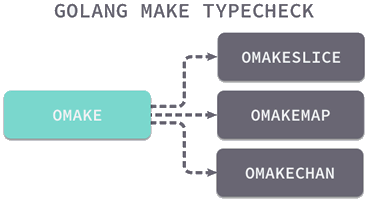Go語言make和new關鍵字的區別及實現原理
2020-07-16 10:05:17
new
在Go語言中,new 函數描述如下:// The new built-in function allocates memory. The first argument is a type, // not a value, and the value returned is a pointer to a newly // allocated zero value of that type. func new(Type) *Type從上面的程式碼可以看出,new 函數只接受一個引數,這個引數是一個型別,並且返回一個指向該型別記憶體地址的指標。同時 new 函數會把分配的記憶體置為零,也就是型別的零值。
【範例】使用 new 函數為變數分配記憶體空間。
var sum *int sum = new(int) //分配空間 *sum = 98 fmt.Println(*sum)當然,new 函數不僅僅能夠為系統預設的資料型別,分配空間,自定義型別也可以使用 new 函數來分配空間,如下所示:
type Student struct {
name string
age int
}
var s *Student
s = new(Student) //分配空間
s.name ="dequan"
fmt.Println(s)
這裡如果我們不使用 new 函數為自定義型別分配空間(將第 7 行注釋),就會報錯:
panic: runtime error: invalid memory address or nil pointer dereference
[signal SIGSEGV: segmentation violation code=0x1 addr=0x0 pc=0x80bd277]
goroutine 1 [running]:
make
make 也是用於記憶體分配的,但是和 new 不同,它只用於 chan、map 以及 slice 的記憶體建立,而且它返回的型別就是這三個型別本身,而不是他們的指標型別,因為這三種型別就是參照型別,所以就沒有必要返回他們的指標了。在Go語言中,make 函數的描述如下:
// The make built-in function allocates and initializes an object of type // slice, map, or chan (only). Like new, the first argument is a type, not a // value. Unlike new, make's return type is the same as the type of its // argument, not a pointer to it. The specification of the result depends on // the type: // Slice: The size specifies the length. The capacity of the slice is // equal to its length. A second integer argument may be provided to // specify a different capacity; it must be no smaller than the // length, so make([]int, 0, 10) allocates a slice of length 0 and // capacity 10. // Map: An empty map is allocated with enough space to hold the // specified number of elements. The size may be omitted, in which case // a small starting size is allocated. // Channel: The channel's buffer is initialized with the specified // buffer capacity. If zero, or the size is omitted, the channel is // unbuffered. func make(t Type, size ...IntegerType) Type通過上面的程式碼可以看出 make 函數的 t 引數必須是 chan(通道)、map(字典)、slice(切片)中的一個,並且返回值也是型別本身。
注意:make 函數只用於 map,slice 和 channel,並且不返回指標。如果想要獲得一個顯式的指標,可以使用 new 函數進行分配,或者顯式地使用一個變數的地址。
Go語言中的 new 和 make 主要區別如下:- make 只能用來分配及初始化型別為 slice、map、chan 的資料。new 可以分配任意型別的資料;
- new 分配返回的是指標,即型別 *Type。make 返回參照,即 Type;
- new 分配的空間被清零。make 分配空間後,會進行初始化;
實現原理
接下來我們將分別介紹一下 make 和 new 在初始化不同資料結構時的具體過程,我們會從編譯期間和執行時兩個不同的階段理解這兩個關鍵字的原理。make
我們已經了解了 make 在建立 slice、map 和 channel 的具體過程,所以在這裡我們也只是會簡單提及 make 相關的資料結構初始化原理。